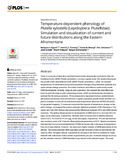| dc.description.abstract | There is a scarcity of laboratory and field-based results showing the movement of the diamondback moth (DBM) Plutella xylostella (L.) across a spatial scale. We studied the population growth of the diamondback moth (DBM) Plutella xylostella (L.) under six constant temperatures, to understand and predict population changes along altitudinal gradients and under climate change scenarios. Non-linear functions were fitted to continuously model DBM development, mortality, longevity and oviposition. We compiled the best-fitted functions for each life stage to yield a phenology model, which we stochastically simulated to estimate the life table parameters. Three temperature-dependent indices (establishment, generation and activity) were derived from a logistic population growth model and then coupled to collected current (2013) and downscaled temperature data from AFRICLIM (2055) for geospatial mapping. To measure and predict the impacts of temperature change on the pest's biology, we mapped the indices along the altitudinal gradients of Mt. Kilimanjaro (Tanzania) and Taita Hills (Kenya) and assessed the differences between 2013 and 2055 climate scenarios. The optimal temperatures for development of DBM were 32.5, 33.5 and 33°C for eggs, larvae and pupae, respectively. Mortality rates increased due to extreme temperatures to 53.3, 70.0 and 52.4% for egg, larvae and pupae, respectively. The net reproduction rate reached a peak of 87.4 female offspring/female/generation at 20°C. Spatial simulations indicated that survival and establishment of DBM increased with a decrease in temperature, from low to high altitude. However, we observed a higher number of DBM generations at low altitude. The model predicted DBM population growth reduction in the low and medium altitudes by 2055. At higher altitude, it predicted an increase in the level of suitability for establishment with a decrease in the number of generations per year. If climate change occurs as per the selected scenario, DBM infestation may reduce in the selected region. The study highlights the need to validate these predictions with other interacting factors such as cropping practices, host plants and natural enemies. | en_US |



